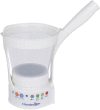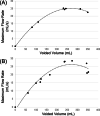A new nomogram of urinary flow rate and volume based on multiple measurements per healthy adult Japanese men using a portable uroflowmeter (P-Flowdiary®)
- PMID: 36008830
- PMCID: PMC9414110
- DOI: 10.1186/s12894-022-01086-5
A new nomogram of urinary flow rate and volume based on multiple measurements per healthy adult Japanese men using a portable uroflowmeter (P-Flowdiary®)
Abstract
Background: To develop a nomogram of urinary volume and flow based on the data of Japanese men without lower urinary tract symptoms and multiple flows per participant whose characteristics were clear.
Methods: Overall, 101 Japanese male volunteers without lower urinary tract symptoms aged between 20 and 59 years were enrolled. A portable uroflowmeter (P-Flowdiary®) was used to record urinary information (flow rate and volume) for 2 successive days. The model (quadratic, linear, or logarithmic regression) most fit for the relationship between maximum flow rate and voided volume was determined. The maximum flow rate at > 150 mL was compared among the 20-29-, 30-39-, 40-49-, and 50-59-year age groups. Nomograms appropriate for the age groups were created.
Results: The mean age, International Prostate Symptom Score, and Overactive Bladder Symptom Score were 38.5 years, 0.42, and 0.24, respectively. The quadratic regression model was the most fit because its mean coefficient determination was 0.93 ± 0.06. The mean maximum flow rate was significantly lower in the 50-59-year age group (21.8 ± 5.05 mL/s, P < 0.01) than in the younger groups (24.14 ± 4.94, 24.05 ± 6.99, and 24.64 ± 5.72 mL/s). The 2 nomograms are Y = 28.99 {1 - exp(- 0.01 × X)} and Y = 25.67 {1 - exp(- 0.01 × X)} for the 20-49- and 50-59-year age groups, respectively.
Conclusions: The nomogram can predict maximum flow rate based on voided volume in Japanese men aged 20-59 years without lower urinary tract symptoms.
Keywords: Age; Man; Nomogram; Urinary flow rate; Urinary volume.
© 2022. The Author(s).
Conflict of interest statement
We have no conflicts of interest, but we were involved in the development of P-Flowdiary®.
Figures



References
MeSH terms
LinkOut - more resources
Full Text Sources
Medical

